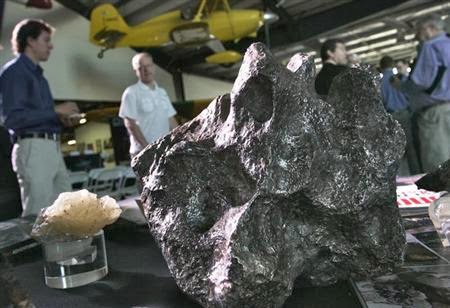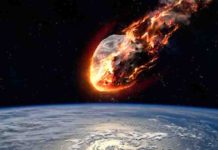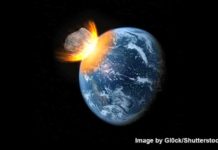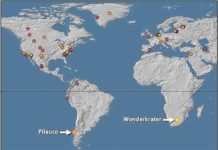
(Reuters) – Mining in space is moving from science fiction to commercial reality but metals magnates on this planet need not fear a mountain of extraterrestrial supply – the aim is to fuel human voyages deeper into the galaxy.
Within three years, two firms plan prospecting missions to passing asteroids. When even a modest space rock might meet demand for metals like platinum or gold for centuries, it is little wonder storytellers have long fantasized that to harness cosmic riches could make, and break, fortunes on Earth.
But with no way to bring much ore or metal down from the heavens, new ventures that have backing from some serious – and seriously rich – business figures, as well as interest from NASA, will focus on using space minerals in interplanetary “gas stations” or to build, support and fuel colonies on Mars.
There may be gold up there, but the draw for now is water for investors willing to get the new industry off the ground.
Governments believe it has a future; NASA has a project that may put astronauts on an asteroid in under a decade and on Mars in the 2030s. And if the costs seem high, grumblers are told that one day the new skills might just save mankind from sharing the fate of the dinosaurs – if we can learn how to stop a massive asteroid smashing into Earth.
“We are dreamers,” declares the web site of Deep Space Industries (DSI), next to an image of a wheel-like metal station hooked up to a giant floating rock. But what the U.S.-based start-up firm calls the first small steps in a “long play” to develop the resources of space are about to happen.
A priority is using hydrogen and oxygen, the components of water locked in compounds on asteroids, to refuel rockets.
Early in 2016, the first of DSI’s exploration satellites, smaller than toasters, will hitch-hike into space on rockets carrying other payloads and start scouting for suitable rocks. The same year, another U.S.-based venture, Planetary Resources, expects to launch prospecting craft hunting viable asteroids.
“They are the low-hanging fruit of the solar system,” said Eric Anderson, an American aerospace engineer and co-founder of Planetary Resources, which lists Google’s Larry Page and Virgin billionaire Richard Branson among its backers.
“They are just there and they are not difficult to get to and they are not difficult to get away from,” he told Reuters.
METALS
Meteorites – chunks that survive and fall to earth after asteroids disintegrate in the atmosphere – yield significant amounts of precious metals like platinum, rhodium, iridium, rhenium, osmium, ruthenium, palladium, germanium and gold.
Planetary Resources estimates some platinum-rich asteroids just 500 meters across could contain more than the entire known reserves of platinum group metals. Studies based on observation and meteorites suggest space is even richer in iron ore.
Wall Street research firm Bernstein notes that a big asteroid called 16 Psyche, in the asteroid belt between Mars and Jupiter and measuring some 200 km (130 miles) across, may contain 17 million billion tones of nickel-iron – enough to satisfy mankind’s current demand for millions of years.
But costs and technical hurdles rule out hauling resources down to Earth in the foreseeable future, experts say. The real value in asteroid mining is for further space travel – and so hydrogen and oxygen reserves are as attractive as any metal.
“It’s ridiculous to believe that asteroid resources will ever compete with terrestrial alternatives and Earth markets,” said Brad Blair, a mining engineer and economist.
Referring to talk of city-sized settlements on Mars, he said: “The reason asteroid mining makes sense is because people might be some day where those resources are. You can’t put an 80,000-person colony on Mars without using the local ‘timber’.
“And if you’re going to use chemical propulsion, it’s going to take a lot of water to get them there.”
The energy released when hydrogen and oxygen combine to make water can power rockets. The presence of both elements in compounds found on asteroids offers scope to set up space factories to make fuel for missions to Mars and beyond as well as offering “pit stops” to extend the lives of satellites.
“We’re going to be looking at propellants for satellites, which is a multi-billion dollar industry to keep them alive,” said Rick Tumlinson, Deep Space Industries’ board chairman and a veteran promoter of commercial space development.
“We’ll eventually be an oasis, a place where you can get air, and we can provide propellants. So we’re a gas station,” Tumlinson told a recent seminar in London.
“You can take the process leftover material, the slag, and use it for shielding, or concrete, and build large structures, and of course there is a percentage of precious metals.”
CAMERAS, LASERS
DSI hopes to launch flying cameras it calls FireFlies early in 2016. Their images will let scientists judge the composition of asteroids they pass. They will use off-the-shelf parts in tried and tested modules, just 10 cm (4 inches) wide.
That first phase should cost some $20 million, DSI chief executive David Gump told Reuters, adding he expects about half to come from government and research institute contracts and half from corporate advertising and corporate sponsorship.
A year later, larger craft would begin two- to three-year missions to land and take samples for analysis. Most dramatic of all, the company sees a “harvester” craft heading out in 2019 to capture and divert the most promising asteroids so that they settle into orbit around Earth by 2021. On these, Gump said, DSI would try to make propellant and mine nickel and iron to make the building components for new structures in space.
“If we are successful producing resources in space then it makes what NASA wants to do, which is going to Mars, that much less expensive,” he said. “It costs a lot of money to launch everything from the ground.”
Planetary Resources plans to send telescopes into space to study asteroids between Earth and the moon. In a later phase, it will send out craft carrying deep-space lasers to gather data on some of the thousands of more distant asteroids.
“By 2020 we will have begun processing asteroidal material in space, and we will have our first interplanetary fuel stop,” Planetary Resources’ Anderson said. “A mission can leave the Earth and stop by the trading post and gas themselves up.”
And while commercial gain from asteroid exploration is drawing investors, the rest of humanity also has an interest.
A shift in climate caused by a big asteroid strike may have killed off the dinosaurs and NASA is taking the risk of another such impact seriously enough to go looking for similar threats.
As mining expert Blair put it: “For survival of the human species, we have to address the asteroids, or they will address us. Because statistically a big enough one will come along that will scrub the planet clean and set it back to zero.”










